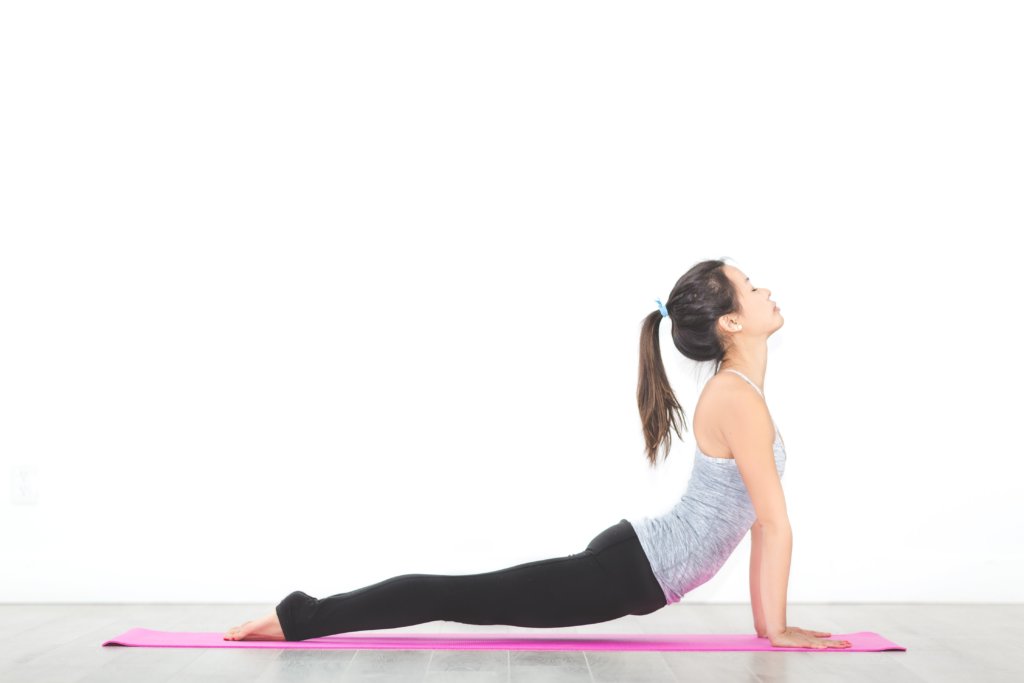As chiropractors and physical therapists in Midtown NYC, we find that a majority of patients in our clinic present with pain where the main culprit is poor posture in a prolonged seated position. Many aspects of today’s society, such as desk jobs, excessive cell phone use, and binge watching on Netflix, promote more and more time spent in these positions.
The muscles in the front of body (pectoralis major/minor, hip flexors) tend to become short and tight while the muscles in the back (rhomboids, lower traps) become overstretched and weak. This combination can lead to pain in the neck, shoulders, upper back, low back, and hips.
Yoga combines strength and flexibility and is an easy way to combat the negative physical effects that typically occur in a sedentary lifestyle. It requires minimal to no equipment and every pose has regressions and progressions to suit every skill level.
The following poses are safe beginner/intermediate moves that can help address areas of the body that typically become tight and painful. Hold the end positions for at least 3-5 breaths and avoid holding your breath throughout the moves.
Upward Facing Dog (Urdhva Mukha Svanasana)
 Steps
Steps
- Begin lying on your stomach with your palms directly underneath your elbows on the floor by your sides.
- Inhale as you push through your palms and straighten your elbows to lift your torso and pelvis off your mat. At the same time, press through the tops of your feet to lift your legs off your mat a few inches.
- Lift through your chest and the crown of your head without letting the ribs flare out. Keep your shoulder blades down and back to avoid shrugging the shoulders and to feel a stretch across the chest and shoulders.
Tips
- Engage your quadriceps strongly to help keep your legs elevated and your kneecaps off the mat.
- Firm your glutes but do not clench them. You should be able to lift your pubic bone towards your breastbone to elongate the front body while lengthening the tailbone towards your heels to elongate the back body.
- Keep your gaze forward or tilt your head back slightly to lift your gaze. Only tilt your head back if you can do so without straining your neck.
Locust Pose (Salabhasana)
Steps
- Begin lying on your stomach with your chin or forehead resting on your mat. Have your arms down by your sides with your palms facing down and keep your legs pressed together straight out behind you with the tops of your feet on the mat.
- Roll your shoulders back and down and engage your thigh muscles so that your kneecaps lift off the floor.
- Inhale as you activate your upper back muscles to lift your head, chest and arms while you also activate your glutes to lift your legs off your mat.
- Reach out through your fingers, toes, and crown of your head to lengthen through the pose.
Tips
- Keep your gaze on the floor just in front of you to keep your neck in line with your spine.
- Maintain a slight chin tuck and avoid shrugging your shoulders to keep your neck long and decrease stress on the back of the neck.
- Keep your legs on the floor if lifting them is too difficult. Work with alternating lifting one leg at time until you are able to lift both together. You can also use a rolled up blanket under the thighs for support.
- Focusing too much on the height of your lift can strain the back and neck. Instead, focus on lengthening the torso forward and the legs back.
Low Lunge (Anjaneyasana)
Steps
- From a tabletop position (on your hands and knees), bring your right foot forward and place it between your hands.
- Gently lower your left knee to your mat and draw your tailbone down as you lift your pubic bone to your navel. You should feel a stretch in the front of your left hip.
- Inhale as you lift your torso up and off your thigh and sweep your arms overhead. Keep your shoulder blades down and back to avoid shrugging your shoulders.
- Look straight ahead or come into a gentle backbend with your gaze lifted as long as it does not cause any neck or back pain.
Tips
- Place a towel or double up your mat underneath your left knee if you have any pain or sensitivity.
- Engage your core to avoid overextending and straining your low back.
- Protect your front knee by making sure it is directly over your ankle.
For the above poses (and all yoga poses in general), you should not experience any pain or strain. Discomfort is normal especially for areas of the body that are tight and restricted but, if you are feeling pain, you may be going too far into the move. Yoga takes time and patience to make progress. As the saying goes, “don’t compare your chapter 1 to someone’s chapter 20.” Everyone’s body is different and the person you are comparing yourself to may have once been in your position.
If you experience pain that does not decrease with regressions and modifications, make an appointment to see a healthcare professional to prevent further injury,
